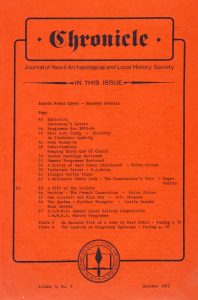1985-Oct-pg50_Final Winter Meetings Reviewed
This article came from the Chronicle published October 1985. Page:50
Winter Meetings Reviewed
Author: Russ Clynick
MARCH 1ST “THE HISTORY OF THE FIRE BRIGADE”. Alan Whyman a former Commander of the East Division of the Somerset Fire Service was the speaker at the Society’s penultimate winter meeting. His subject, “The History of the Fire Brigade” was one aspect of Industrial Archaeology which deserves more attention than it has so far been given. Throughout the ages fire has been a continual enemy of man. Mr. Whyman described the Roman scene when well organised teams of vigiles or watchers and firefighters were at hand to cope with outbreaks in Rome. Fairly sophisticated pumps were available as well as teams of water bucket carriers. During the Dark Ages there did not seem to be any concerted system to cope with conflagrations, other than by pulling down the buildings affected and by the “couvre feu” system of ensuring that fires were extinguished at night which has given rise to the modern word “curfew”. Gradually, the development of means of squirting water such as primitive forms of pressure pumps to combat fires brought about big changes. The speaker gave accounts of some history making conflagrations such as the Great Fire of London in 1666 and the destruction of the Houses of Parliament in the late 19th century. He spoke of the coming of insurance against fires, culminating in the proliferation of rival Fire Insurance Companies and the use of fire marks to identify those properties which had been insured. The formation of brigades replaced the often useless efforts of the Parish Firemen. In the History of tine Fire Brigade two famous names stand out James Braidwood, who was appointed to supervise fire fighting in Edinburgh and later in London, introduced strict training and many new ideas Captain Merryweather introduced greatly improved fire engines with high powered pumps and extension ladders and made the work of the Fire Service much more effective. Legislation has made an enormous improvement to the Service, which is now established nation-wide, with regional divisions. Mr. Whyman added a “local touch” by showing slides of the different stations which were once Yeovil’s pride and joy. He also described the Somerset Fire Service headquarters at Hestercombe near Taunton. Mr. Whyman acknowledged his great debt to Leslie Brooke for his help in the preparation of an excellent set of slides and your humble scribe proposed a vote of thanks for a most entertaining and instructive talk.
MARCH 29TH “BADBURY RINGS”. The last of the winter meetings was addressed by Mr. Norman H. Field, Vice-President of the D.R.N.H.S., his subject being “Badbury Rings” which was recently taken into the care of the National Trust. The site is situated in the valley of the river Stour and is a magnificent Iron huge Fort, occupied by the Durotriges Tribe from at least 50 BC to 43 AD. Finds of pottery sherds and coins have been made over a wide area occupied by this tribe in Somerset, Hampshire and Dorset and aerial photography has revealed evidence of remains of their round huts. Later Badbury became a Roman settlement of great strategic importance controlling communication between Exeter, Salisbury, Bath and Dorchester, in addition to the trading route from the Continent through Poole and Hengistbury Head. The speaker, a former master at Poole Grammar School and an amateur archaeologist of much experience, said that no excavation had been carried out as yet at Badbury. It may well be that, under the care of the National Trust, some limited work may be undertaken. Mr. Field’s excellent slides, which included maps and detailed plans of the area and his masterly exposition of his subject helped to set the scene for a visit by the Society to Badbury Rings in September. Mr. Hayward expressed warm thanks to Mr. Field on our behalf.
